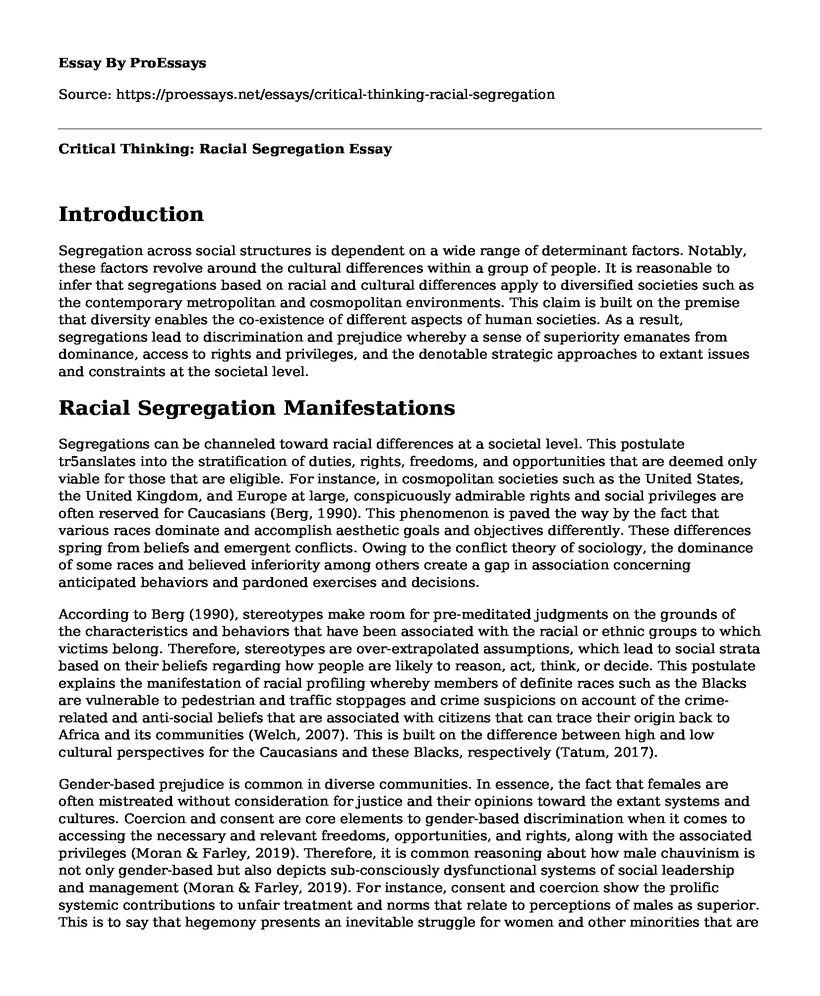Introduction
Segregation across social structures is dependent on a wide range of determinant factors. Notably, these factors revolve around the cultural differences within a group of people. It is reasonable to infer that segregations based on racial and cultural differences apply to diversified societies such as the contemporary metropolitan and cosmopolitan environments. This claim is built on the premise that diversity enables the co-existence of different aspects of human societies. As a result, segregations lead to discrimination and prejudice whereby a sense of superiority emanates from dominance, access to rights and privileges, and the denotable strategic approaches to extant issues and constraints at the societal level.
Racial Segregation Manifestations
Segregations can be channeled toward racial differences at a societal level. This postulate tr5anslates into the stratification of duties, rights, freedoms, and opportunities that are deemed only viable for those that are eligible. For instance, in cosmopolitan societies such as the United States, the United Kingdom, and Europe at large, conspicuously admirable rights and social privileges are often reserved for Caucasians (Berg, 1990). This phenomenon is paved the way by the fact that various races dominate and accomplish aesthetic goals and objectives differently. These differences spring from beliefs and emergent conflicts. Owing to the conflict theory of sociology, the dominance of some races and believed inferiority among others create a gap in association concerning anticipated behaviors and pardoned exercises and decisions.
According to Berg (1990), stereotypes make room for pre-meditated judgments on the grounds of the characteristics and behaviors that have been associated with the racial or ethnic groups to which victims belong. Therefore, stereotypes are over-extrapolated assumptions, which lead to social strata based on their beliefs regarding how people are likely to reason, act, think, or decide. This postulate explains the manifestation of racial profiling whereby members of definite races such as the Blacks are vulnerable to pedestrian and traffic stoppages and crime suspicions on account of the crime-related and anti-social beliefs that are associated with citizens that can trace their origin back to Africa and its communities (Welch, 2007). This is built on the difference between high and low cultural perspectives for the Caucasians and these Blacks, respectively (Tatum, 2017).
Gender-based prejudice is common in diverse communities. In essence, the fact that females are often mistreated without consideration for justice and their opinions toward the extant systems and cultures. Coercion and consent are core elements to gender-based discrimination when it comes to accessing the necessary and relevant freedoms, opportunities, and rights, along with the associated privileges (Moran & Farley, 2019). Therefore, it is common reasoning about how male chauvinism is not only gender-based but also depicts sub-consciously dysfunctional systems of social leadership and management (Moran & Farley, 2019). For instance, consent and coercion show the prolific systemic contributions to unfair treatment and norms that relate to perceptions of males as superior. This is to say that hegemony presents an inevitable struggle for women and other minorities that are often alienated from enjoying the rights and privileges of citizens (Moran & Farley, 2019).
Similarly, representations differ according to how the more comprehensive social structure depicts the essence of justice when it comes to accessing opportunities such as political leadership. Welch (2007) infers that misrepresented communities in a wide range of social environments emanate from a lack of informed consent in the system, making it difficult for minorities to fight segregation. For instance, when it comes to coercion, it is vital to note the ignorance of the needs and rights of the minorities. Aldama (2016) postulates that it is common sense to spell out the correlation between forms of prejudice and their chains of causality to discern the source of social issues for effective solution finding through informed interventions.
References
Aldama, F. L. (2016). Introduction: Putting the Pop in Latina/o Culture. In The Routledge Companion to Latina/o Popular Culture (pp. 17-36). Routledge. PDF.
Berg, C. R. (1990). Stereotyping in films in general and of the Hispanic in particular. Howard Journal of Communications, 2(3), 286-300. PDF.
Moran, R., & Farley, M. (2019). Consent, coercion, and culpability: is prostitution stigmatized work or an exploitive and violent practice rooted in sex, race, and class inequality?. Archives of sexual behavior, 1-7. Retrieved from: https://www.spaceintl.org/assets/Uploads/MoranFarley2019.pdf
Tatum, C. M. (2017). Chicano popular culture: Que hable el pueblo. University of Arizona Press. PDF.
Welch, K. (2007). Black criminal stereotypes and racial profiling. Journal of contemporary criminal justice, 23(3), 276-288. Retrieved from: http://www.academia.edu/download/35483287/Welch_1.pdf
Cite this page
Critical Thinking: Racial Segregation. (2022, Mar 10). Retrieved from https://proessays.net/essays/critical-thinking-racial-segregation
If you are the original author of this essay and no longer wish to have it published on the ProEssays website, please click below to request its removal:
- Research Proposal on the Necessity of Parental Involvement in the Education Life of a Child
- Essay on Children Education in Homeless Families
- Gender Issues in "A Raisin in the Sun" Essay Example
- Gang Violence at Harper High School Essay Example
- Research Paper on Learn Change Through Systems Think: Peter Senge's 5 Disciplines
- Essay Sample on Interprofessional Collaboration: Enhancing Patient Care & Reducing Medical Errors
- Cognitive Ability: 100% Innate or Learned? - Free Essay Example







